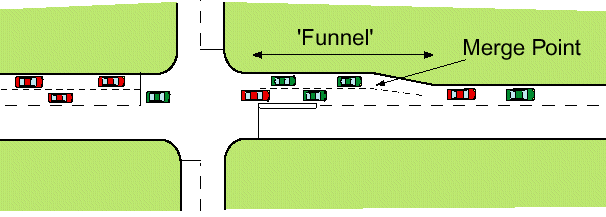The mechanics of a funnel are of interest. Let’s start by considering a two-into-one situation under ideal conditions where both entry lanes are fully used. As the lights turn green, traffic will move freely. As the first cars reach the point of restriction, a ‘shock wave’ will start to work back to the stop line as the funnel fills. When this reaches back to the stop line, the capacity will be limited to single lane saturation flow (approximately). This is the same sort of effect that a flare has on capacity.
What is the best way to model this? Firstly, it is necessary to highlight one way that is NOT acceptable. In OSCADY, the exit width restriction looks to be an obvious way to account for funnels. It isn’t. This value is designed to account for situations where the lanes are a little narrower on the exit than at the stop line; it does NOT account for a reduction in the NUMBER of lanes. In fact, attempting to use the exit width restriction value to model a two-into-one situation (say) leads to a very modest reduction in the capacity predicted by OSCADY when compared to a situation with no funnel, far more modest than you might expect in reality.

The question is how best to model funnels. One way is by using the flared approach modelling facilities (and this applied equally to TRANSYT and OSCADY). Simulation testing has indicated that a value to use for the number to enter for the storage of the flare is the number of extra vehicles that fit into the funnel. This works for the idealised situation (described above). However, this idea will need adjusting when the approach lanes are used unequally, as is usually the case. Then it would seem logical to use the flare approach model again, but decide the storage value on the basis of which side of the junction is restricting capacity most. If, on average, the queue on the feeder lanes is less than the funnel can cope with, then the storage will be the average utilisation of the least-used lane. On the other hand, if the funnel is regularly filled, the storage value should be the number of vehicles that can use the extra space in the funnel.
Further complications to think about are the effect of turning traffic and where the two (or more) lanes on the approach have to be modelled as separate links. Solutions in these cases are likely to be quite specific.